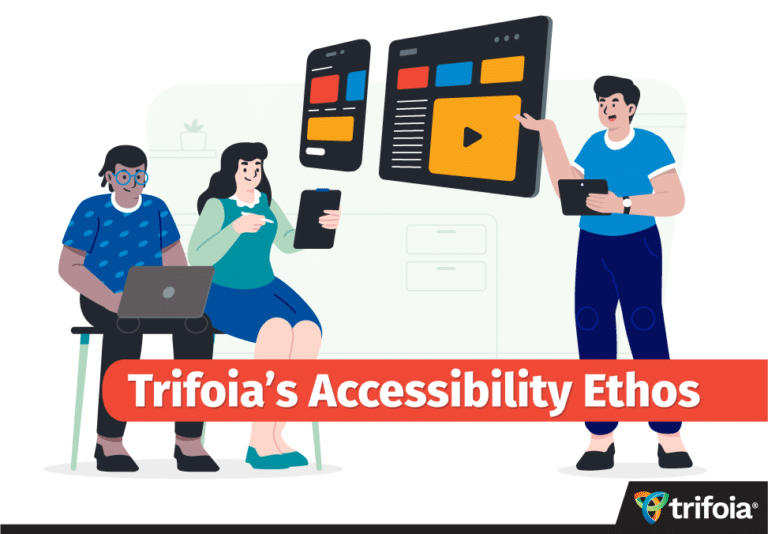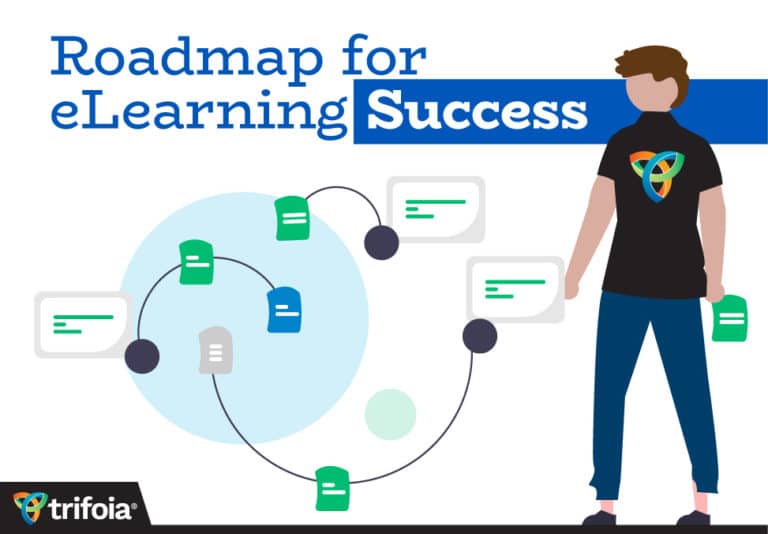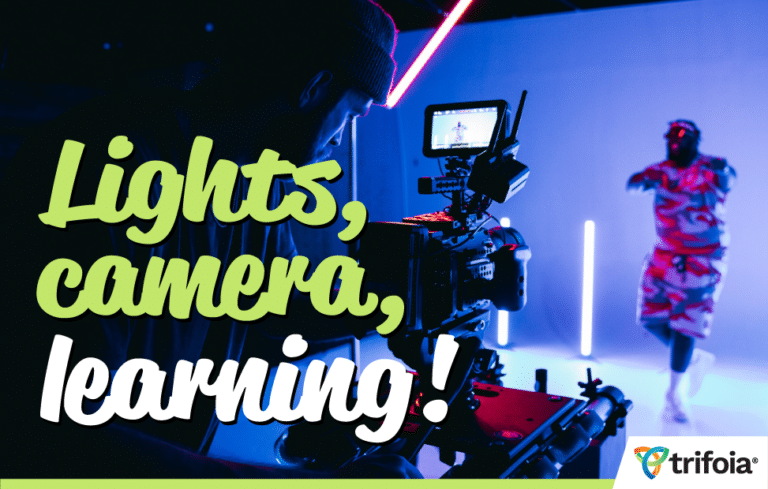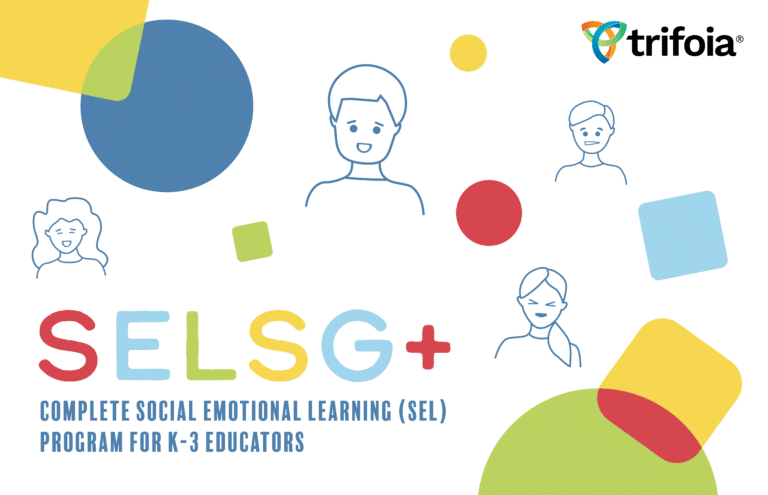Meet Trifoia’s Multimedia Team
How does a small team convert a pair of childhood development instructional curriculums into cutting-edge, custom digital training programs? When that team includes talented software developers, experienced instructional designers, and award-winning media producers, all passionate about making learning accessible to students and teachers alike, no challenge is too big.
Over a week this summer, Trifoia’s media production team transformed a small studio in Eugene, Oregon into a visual showcase for two clients: the University of Alabama College of Education, and the Montana-based Pyramid Model Consortium.
When researchers at the University of Alabama received a $5 million federal grant last year to study the effects of Social and Emotional Learning (SEL) in elementary school classrooms, they turned to Trifoia’s research team to help develop SEL best practices for kindergarten-through-3rd-grade teachers, through an initiative called the Social and Emotional Learning Study Group (SELSG+).
Likewise, Trifoia had developed learning content and materials for the Pyramid Model Consortium in the past. But the research institute specializing in early childhood behavioral intervention and support needed a compelling visual tool to help teachers and instructors utilize a digitally focused, Practice Based Coaching component of Pyramid’s evidence-based practices in their own communities.
From left to right: Christopher Hawkins, Director of Photography, Georgia Harter, Director & Producer, Trista Vonada, SME for PMC-PBC and Jordan Blaisdell, Assistant Director
For Trifoia Media Project Manager and Producer Georgia Harter, and Multimedia Asset Developer Jordan Blaisdell, reimagining these live curriculums on a website or mobile app format would mean tapping into their technical experience, project management ability, and people skills.
From left to right: Christopher Hawkins, Director of Photography, Georgia Harter, Director & Producer, Trista Vonada, SME for PMC-PBC and Jordan Blaisdell, Assistant Director
Harter has a background in independent filmmaking, and a passion for caring for those in need. She spent years volunteering at warming centers for unhoused members of the community, while earning a degree in multimedia design from Lane Community College.
“A lot of these children are experiencing real trauma and pain,” Harter said of the young students being served by the university and research institute. “These projects are really important because teachers need better tools for understanding their students’ unique, emotional needs.”
Blaisdell has more than a decade of media and videography experience, working for companies, television newsrooms and creative studios since receiving his degree in electronic media from the University of Oregon School of Journalism and Communication.
“Now more than ever, learners are incredibly visually oriented,” Blaisdell said. “If you’re going to make educational media that has a visual component, you’re going to need some media professionals that not only understand the fundamentals, but know how to use those techniques to evoke emotions.”
Harter and Blaisdell frequently team up to create media-rich components of Trifoia’s digital learning products, including explainer videos for student literacy development programs, online parenting classes and much more. Though Trifoia may be best known for e-learning software development, its media production work has earned it 12 national Telly Awards for excellence in video production.
The SELSG+ and Practice Based Coaching shoots would put Trifoia’s media skills to the test once more.
One of the many things that sets Trifoia’s work apart from other e-learning companies is its ability to ingrain evidence based learning strategies and research driven best practices into each of its projects.
While Harter and Blaisdell handled all the logistics – coordinating with on-screen subject matter experts, assembling a production crew, renting equipment and securing a location for a week of shooting – Trifoia Instructional Designer and Content Creator Ryan Harper, PhD, worked with Social Emotional Learning subject matter experts to write scripts designed to bring the most effective learning processes out of the SELSG+ shoot.
Harter and Blaisdell then reviewed the material through a media lens, figuring out how to best capture and communicate the material.
https://youtu.be/WeQU3xNHho8
For the SELSG+ shoot, project lead Dr. Greg Benner, Special Education and Implementation Science professor at the University of Alabama, joined Harter and Blaisdell on set. They filmed Benner speaking directly to teachers and giving overviews of the Social and Emotional Learning concepts. This footage will eventually go into each of the e-learning modules being developed into a website and app by Trifoia’s software team, covering the different aspects of the curriculum.
“It’s a good example of our typical process,” Blaisdell said. “Our clients have a life’s work, but not expertise in creating videos or websites. That’s where the collaboration happens.
Making the content accessible to different types of learners was crucial, since Trifoia’s work always focuses on the user’s experience with the end product.
“We think about accessibility all the time,” Harter said. “We tried to accomplish those accessibility goals by giving teachers the opportunity to absorb the information in three distinct ways that are engaging,” Harter said. She and Blaisdell put Benner on screen talking and connecting in an emotional way with teachers, letting viewers hear his words and observe his expressions. On-screen graphics also let viewers read instructions along with the video footage.
“One of our big challenges we take on at Trifoia that’s unique to media production is we’re taking these huge curriculums that an outsider might find dense,” Blaisdell said, “and we make it into something that’s going to hold your attention, that’s going to be something pleasant to watch and keep people’s attention. That’s why video is such an effective tool for education.”
A week of filming yielded a wealth of material for the SELSG+ and Practice Based Coaching shoots. The Pyramid Model Consortium’s Practice Based Coaching course is scheduled to go live in late August, while Trifoia will deliver a SELSG+ prototype to the University of Alabama researchers in September.
One of the most rewarding aspects of Harter’s and Blaisdell’s jobs is working with passionate educators, researchers and businesses across the country. For Harter, who directs Trifoia’s video productions, the diversity of these projects and the audiences they serve are a reminder of the importance of representation and equity in her profession.
“It’s one of my top priorities to use my position here at Trifoia to get more women involved in tech and working on our video productions,” Harter said. “In my experience, I’ve often been the only female on set. I feel like it’s my responsibility to hire more women, more queer, non-binary folks, more people of color. When you’re collaborating with a more diverse crew, you end up with a more authentic final product that reflects the diversity of your end users.”






